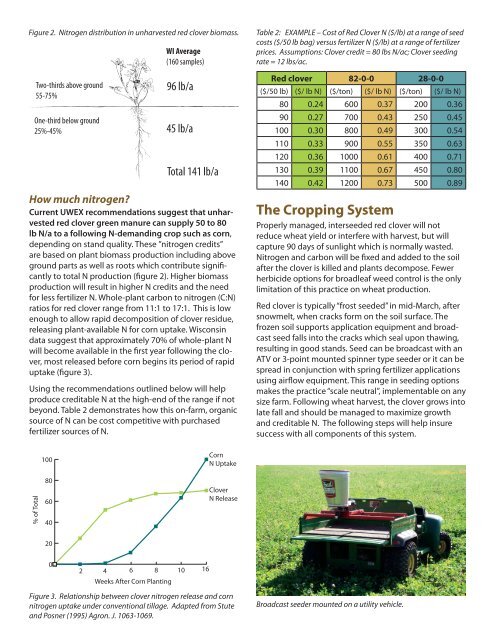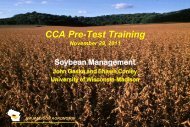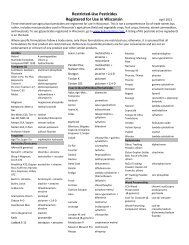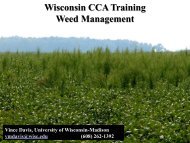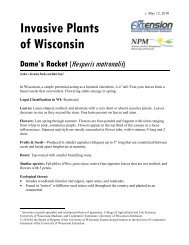Frost Seeding Red Clover in Winter Wheat - CoolBeans - UWEX ...
Frost Seeding Red Clover in Winter Wheat - CoolBeans - UWEX ...
Frost Seeding Red Clover in Winter Wheat - CoolBeans - UWEX ...
You also want an ePaper? Increase the reach of your titles
YUMPU automatically turns print PDFs into web optimized ePapers that Google loves.
Figure 2. Nitrogen distribution <strong>in</strong> unharvested red clover biomass.<br />
Two-thirds above ground<br />
55-75%<br />
One-third below ground<br />
25%-45%<br />
WI Average<br />
(160 samples)<br />
96 lb/a<br />
45 lb/a<br />
Total 141 lb/a<br />
How much nitrogen<br />
Current <strong>UWEX</strong> recommendations suggest that unharvested<br />
red clover green manure can supply 50 to 80<br />
lb N/a to a follow<strong>in</strong>g N-demand<strong>in</strong>g crop such as corn,<br />
depend<strong>in</strong>g on stand quality. These ”nitrogen credits”<br />
are based on plant biomass production <strong>in</strong>clud<strong>in</strong>g above<br />
ground parts as well as roots which contribute significantly<br />
to total N production (figure 2). Higher biomass<br />
production will result <strong>in</strong> higher N credits and the need<br />
for less fertilizer N. Whole-plant carbon to nitrogen (C:N)<br />
ratios for red clover range from 11:1 to 17:1. This is low<br />
enough to allow rapid decomposition of clover residue,<br />
releas<strong>in</strong>g plant-available N for corn uptake. Wiscons<strong>in</strong><br />
data suggest that approximately 70% of whole-plant N<br />
will become available <strong>in</strong> the first year follow<strong>in</strong>g the clover,<br />
most released before corn beg<strong>in</strong>s its period of rapid<br />
uptake (figure 3).<br />
Us<strong>in</strong>g the recommendations outl<strong>in</strong>ed below will help<br />
produce creditable N at the high-end of the range if not<br />
beyond. Table 2 demonstrates how this on-farm, organic<br />
source of N can be cost competitive with purchased<br />
fertilizer sources of N.<br />
Table 2: EXAMPLE – Cost of <strong>Red</strong> <strong>Clover</strong> N ($/lb) at a range of seed<br />
costs ($/50 lb bag) versus fertilizer N ($/lb) at a range of fertilizer<br />
prices. Assumptions: <strong>Clover</strong> credit = 80 lbs N/ac; <strong>Clover</strong> seed<strong>in</strong>g<br />
rate = 12 lbs/ac.<br />
<strong>Red</strong> clover 82-0-0 28-0-0<br />
($/50 lb) ($/ lb N) ($/ton) ($/ lb N) ($/ton) ($/ lb N)<br />
80 0.24 600 0.37 200 0.36<br />
90 0.27 700 0.43 250 0.45<br />
100 0.30 800 0.49 300 0.54<br />
110 0.33 900 0.55 350 0.63<br />
120 0.36 1000 0.61 400 0.71<br />
130 0.39 1100 0.67 450 0.80<br />
140 0.42 1200 0.73 500 0.89<br />
The Cropp<strong>in</strong>g System<br />
Properly managed, <strong>in</strong>terseeded red clover will not<br />
reduce wheat yield or <strong>in</strong>terfere with harvest, but will<br />
capture 90 days of sunlight which is normally wasted.<br />
Nitrogen and carbon will be fixed and added to the soil<br />
after the clover is killed and plants decompose. Fewer<br />
herbicide options for broadleaf weed control is the only<br />
limitation of this practice on wheat production.<br />
<strong>Red</strong> clover is typically “frost seeded” <strong>in</strong> mid-March, after<br />
snowmelt, when cracks form on the soil surface. The<br />
frozen soil supports application equipment and broadcast<br />
seed falls <strong>in</strong>to the cracks which seal upon thaw<strong>in</strong>g,<br />
result<strong>in</strong>g <strong>in</strong> good stands. Seed can be broadcast with an<br />
ATV or 3-po<strong>in</strong>t mounted sp<strong>in</strong>ner type seeder or it can be<br />
spread <strong>in</strong> conjunction with spr<strong>in</strong>g fertilizer applications<br />
us<strong>in</strong>g airflow equipment. This range <strong>in</strong> seed<strong>in</strong>g options<br />
makes the practice “scale neutral”, implementable on any<br />
size farm. Follow<strong>in</strong>g wheat harvest, the clover grows <strong>in</strong>to<br />
late fall and should be managed to maximize growth<br />
and creditable N. The follow<strong>in</strong>g steps will help <strong>in</strong>sure<br />
success with all components of this system.<br />
% of Total<br />
100<br />
80<br />
60<br />
40<br />
Corn<br />
N Uptake<br />
<strong>Clover</strong><br />
N Release<br />
20<br />
0<br />
2 4 6 8 10 16<br />
Weeks After Corn Plant<strong>in</strong>g<br />
Figure 3. Relationship between clover nitrogen release and corn<br />
nitrogen uptake under conventional tillage. Adapted from Stute<br />
and Posner (1995) Agron. J. 1063-1069.<br />
Broadcast seeder mounted on a utility vehicle.


